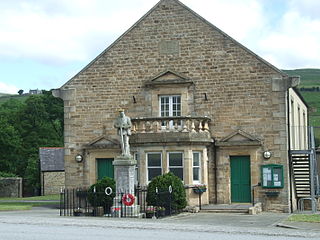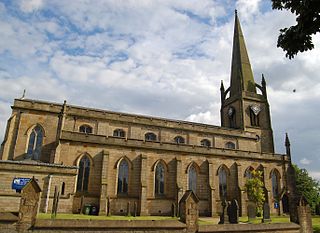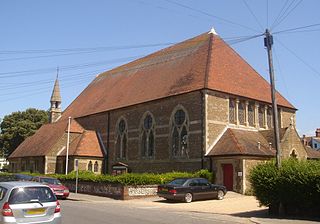
St John's Chapel is a village in County Durham, in England. It is situated in Weardale, on the south side of the River Wear on the A689 road between Daddry Shield and Ireshopeburn. The 2001 census reported a population of 307, of whom only 43 were children under 16. In 1980 there were 160 children in the village.

Sevenoaks Weald is a village and civil parish in the Sevenoaks District of Kent, England. The parish is located on the Low Weald, immediately south of Sevenoaks town, with the village of Sevenoaks Weald at its centre. It was formed in 1894 from part of the ancient parish of Sevenoaks.

St Thomas the Martyr's is a Church of England parish church of the Anglo-Catholic tradition, in Oxford, England, near Oxford railway station in Osney. It is located between Becket Street to the west and Hollybush Row to the east, with St Thomas Street opposite.

Holy Trinity Episcopal Church in Collington, Maryland is a historic place of worship dating back more than three centuries. Originally a chapel of ease for Queen Anne Parish, it became a separate parish in 1844.

St George's Church is an Anglican church in the Kemptown area of Brighton, in the English city of Brighton and Hove. It was built at the request of Thomas Read Kemp, who had created and financed the Kemp Town estate on the cliffs east of Brighton in the early 19th century, and is now regarded as the parish church of the wider Kemptown area. It is a Grade II listed building.

St. Mary's Church, Broadwater, is a Church of England parish church in the Worthing Deanery of the Diocese of Chichester. It serves the ecclesiastical parish of Broadwater, West Sussex and is named after St. Mary. St Mary's is one of several sites in this benefice along with Queen Street and St. Stephen's.

St John the Evangelist is an Anglican church on Friern Barnet Road in north London. It is a late example of the Gothic Revival Style by Victorian architect John Loughborough Pearson, begun in 1890-91 and completed after his death by his son Frank Loughborough Pearson.

St James' Parish Church is an Anglican parish church serving the parish of Wetherby with Linton in Wetherby, West Yorkshire, England.

St Mark's Church is a former Anglican church in the Kemptown area of Brighton, part of the English city of Brighton and Hove. Originally intended as the private chapel of the adjacent St Mary's Hall school, it was partly built in 1838 at the request of Frederick Hervey, 1st Marquess of Bristol; but arguments over whether or not it should also be open to the public delayed its completion for more than 10 years. It became the parish church of Kemptown in 1873, but declining attendances resulted in a declaration of redundancy in 1986. At that time it was taken over by the school and became its chapel, nearly 150 years after this was first proposed. The Early English-style stone and concrete structure has been criticised by architectural historians, but has been listed at Grade II by English Heritage for its architectural and historical importance.

Christ Church and its burial grounds in Worthing, England, were consecrated in 1843 by the Bishop of Chichester, Ashurst Turner Gilbert, to meet the need for church accommodation for the poor. Built by subscription between 1840 and 1843, the Church was initially regarded as a chapel of ease to St Mary's Church in Broadwater. The chapel of ease was upgraded to the status of church with its own parish in 1855.

St George's Church is an Anglican parish church serving Tyldesley and Shakerley in Greater Manchester, England. It is part of Leigh deanery in the archdeaconry of Salford and the diocese of Manchester. The church, together with St Stephen's Church, Astley and St John's Church, Mosley Common is part of the united benefice of Astley, Tyldesley and Mosley Common.

St George's Church is an Anglican church in the East Worthing area of the borough of Worthing, one of seven local government districts in the English county of West Sussex. Built in 1867–68 to serve new residential development in the southeast of the town, the Decorated Gothic-style structure was extended later in the 19th century, and expanded its reach further by founding three mission halls elsewhere in Worthing. English Heritage has listed it at Grade C for its architectural and historical importance.

St Andrew's Church, in Chippenham, Wiltshire, England, is a Church of England parish church. It is one of four Anglican parish churches in the town, and serves the south and east of Chippenham. The church is situated in the Market Place, beside the town centre, and is Grade II* listed.

Holy Trinity Church, commonly known as Horwich Parish Church, is a Grade II listed building in Horwich, Greater Manchester, England. It is an active Church of England parish church and part of the Deane deanery in the archdeaconry of Bolton, diocese of Manchester. Holy Trinity Church is now part of the United Benefice of Horwich and Rivington, which includes the other two Anglican churches in Horwich, St Catherine's Church and St Elizabeth's Church, and Rivington Anglican Church.

St George's Church stands in the centre of the town of Poynton, Cheshire, England. It is an active Anglican parish church in the deanery of Cheadle, the archdeaconry of Macclesfield, and the diocese of Chester. The church is recorded in the National Heritage List for England as a designated Grade II listed building. It is the tallest building in Poynton.

St Mark's Church stands on the corner of Southport Road and Jacksmere Lane in Scarisbrick, Lancashire, England. Built in 1848–51, it is an active Anglican parish church in the deanery of Ormskirk, the archdeaconry of Warrington, and the diocese of Liverpool. The parish and benefice includes The Good Shepherd Mission, a tin chapel also located in Scarisbrick on Smithy Lane.

The Church of St John The Baptist, Leytonstone, is a 19th-century Church of England parish church in Leytonstone, East London, occupying a prominent position in the High Road. It is a Grade II listed building.

Holy Trinity Church, also known as the Church of the Holy Trinity, is a Church of England parish church in the town of Reading in the English county of Berkshire. It is situated on the Oxford Road some 500 metres (1,600 ft) west of the town centre. It is a Grade II listed building.

Cathedral of St Michael and St John is a heritage-listed Roman Catholic cathedral at 107 William Street, Bathurst, Bathurst Region, New South Wales, Australia. It was designed by Charles Hansom and built from 1857 to 1861 by Edward Gell. It is also known as Cathedral of Saints Michael and John. The cathedral is the episcopal see of the Roman Catholic Bishop of Bathurst. The property is owned by the Roman Catholic Diocese of Bathurst. It was added to the New South Wales State Heritage Register on 5 June 2012.

St Paul and St Stephen's Church is a Church of England church located in Stroud Road, Gloucester, Gloucestershire. St Paul's church was built between 1882 and 1883. St Stephen's church was built between 1898 and 1900. St Stephen's church was closed in 2010 and the church was merged with St Paul's which became St Paul and St Stephen's church. Closely associated with the church is St Paul's Church of England Primary school located in New Street, Gloucester which opened in 1870.





















